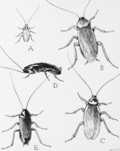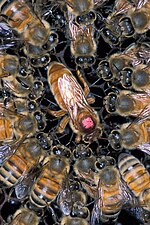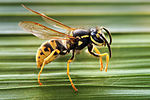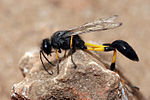Search results
Appearance
- Cockroaches (or roaches) are insects belonging to the order Blattodea (Blattaria). About 30 cockroach species out of 4,600 are associated with human habitats...78 KB (8,297 words) - 02:17, 28 June 2024
- Blattodea is an order of insects that contains cockroaches and termites. Formerly, termites were considered a separate order, Isoptera, but genetic and...26 KB (2,756 words) - 21:16, 4 July 2024
- An ant colony is a population of ants, typically from a single species, capable of maintaining their complete lifecycle. Ant colonies are eusocial, communal...16 KB (1,861 words) - 20:45, 11 July 2024
- The gyne (/ˈɡaɪn/, from Greek γυνή, "woman") is the primary reproductive female caste of social insects (especially ants, wasps, and bees of order Hymenoptera...5 KB (621 words) - 21:15, 30 March 2024
- The Vespidae are a large (nearly 5000 species), diverse, cosmopolitan family of wasps, including nearly all the known eusocial wasps (such as Polistes...6 KB (634 words) - 21:18, 15 July 2024
- Hornets (insects in the genus Vespa) are the largest of the eusocial wasps, and are similar in appearance to yellowjackets, their close relatives. Some...26 KB (3,005 words) - 02:45, 10 July 2024
- Worker policing is a behavior seen in colonies of social hymenopterans (ants, bees, and wasps) whereby worker females eat or remove eggs that have been...25 KB (3,055 words) - 00:17, 28 March 2024
- Eusociality evolved repeatedly in different orders of animals, notably termites and the Hymenoptera (the wasps, bees, and ants). This 'true sociality'...21 KB (2,699 words) - 12:37, 29 October 2023
- Parasitoid wasps are a large group of hymenopteran superfamilies, with all but the wood wasps (Orussoidea) being in the wasp-waisted Apocrita. As parasitoids...36 KB (3,534 words) - 07:15, 29 June 2024
- Weaver ants or green ants are eusocial insects of the Hymenoptera family Formicidae belonging to the tribe Oecophyllini. Weaver ants live in trees (they...29 KB (3,269 words) - 18:32, 1 July 2024
- There are various disparate groups of wingless insects. Apterygota are a subclass of small, agile insects, distinguished from other insects by their lack...4 KB (429 words) - 00:53, 3 July 2024
- Mass provisioning is a form of parental investment in which an adult insect, most commonly a hymenopteran such as a bee or wasp, stocks all the food for...6 KB (723 words) - 19:28, 6 December 2023
- Progressive provisioning is a term used in entomology to refer to a form of parental behavior in which an adult (most commonly a hymenopteran such as a...2 KB (284 words) - 23:56, 8 November 2023
- Sceliphron, also known as black mud daubers or black mud-dauber wasps, is a genus of Hymenoptera of the Sphecidae family of wasps. They are solitary mud...7 KB (612 words) - 15:53, 12 July 2024
- The sweat bee genus Lasioglossum is the largest of all bee genera, containing over 1800 species in numerous subgenera worldwide. They are highly variable...5 KB (482 words) - 09:12, 14 August 2023
- In zoology, an inquiline (from Latin inquilinus, "lodger" or "tenant") is an animal that lives commensally in the nest, burrow, or dwelling place of an...6 KB (766 words) - 15:47, 16 November 2023
- Trophallaxis (/ˌtroʊfəˈlæksɪs/) is the transfer of food or other fluids among members of a community through mouth-to-mouth (stomodeal) or anus-to-mouth...16 KB (1,981 words) - 23:32, 8 May 2024
- Haplodiploidy is a sex-determination system in which males develop from unfertilized eggs and are haploid, and females develop from fertilized eggs and...19 KB (2,233 words) - 23:15, 26 December 2023
- The collective behaviors of social caterpillars falls into five general categories: collective and cooperative foraging, group defense against predators...13 KB (1,833 words) - 18:57, 9 December 2023
- Hymenoptera is a large order of insects, comprising the sawflies, wasps, bees, and ants. Over 150,000 living species of Hymenoptera have been described...28 KB (2,803 words) - 22:17, 4 July 2024


















